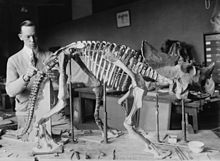Brachyceratops
| Brachyceratops | |
|---|---|

| |
| Holotype specimen USNM 7951 mounted in the Smithsonian | |
| Scientific classification | |
| Domain: | Eukaryota |
| Kingdom: | Animalia |
| Phylum: | Chordata |
| Clade: | Dinosauria |
| Clade: | †Ornithischia |
| Clade: | †Ceratopsia |
| Family: | †Ceratopsidae |
| Subfamily: | †Centrosaurinae |
| Genus: | †Brachyceratops Gilmore, 1914 |
| Species: | †B. montanensis
|
| Binomial name | |
| †Brachyceratops montanensis Gilmore, 1914
| |
Brachyceratops ('short horned face') is a
Brachyceratops has historically been known from juvenile remains, with one specimen having since been re-classified as
History of discovery

Brachyceratops montanensis, the
All that was found were incomplete and jumbled remains of five juvenile individuals of about 1.5 m (5 feet) in length.[3] It has been speculated that these juveniles may have been nest mates that stayed together after hatching.[3] The holotype specimen is USNM 7951, a partial skull. The paratypes are USNM 7952, a snout, USNM 7953, a partial skeleton with skull and USNM 7957, a foot. The material is disarticulated but the preservation is excellent.[5] In 1917 Gilmore published a monograph on Brachyceratops in which a reconstruction of the skeleton as a whole was given.[6]
In 1939 Gilmore referred a larger subadult specimen, USNM 14765, to Brachyceratops.
As Brachyceratops is known only from the
Description
Among the five original specimens parts of three skulls were discovered, detached from their owner's body and fragmented.
Classification

Brachyceratops belonged to the
Paleoecology
Dinosaurs that lived alongside Brachyceratops include the basal
See also
References
- ^ S2CID 86218327. Retrieved 2010-08-19.
- ^ a b Andrew T. McDonald & John R. Horner, (2010). "New Material of "Styracosaurus" ovatus from the Two Medicine Formation of Montana", In: Michael J. Ryan, Brenda J. Chinnery-Allgeier, and David A. Eberth (eds), New Perspectives on Horned Dinosaurs: The Royal Tyrrell Museum Ceratopsian Symposium, Indiana University Press, 656 pp.
- ^ ISBN 0-7853-0443-6.
- ^ C.W. Gilmore, 1914, "A new ceratopsian dinosaur from the Upper Cretaceous of Montana, with note on Hypacrosaurus", Smithsonian Miscellaneous Collections 63(3): 1-10[1]
- ^ Dodson, P., 1996, The Horned Dinosaurs — A natural history, Princeton University Press, p. 154
- ^ C.W. Gilmore, 1917, "Brachyceratops, a ceratopsian dinosaur from the Two Medicine Formation of Montana, with notes on associated fossil reptiles", United States Geological Survey Professional Paper 103: 1-45
- ^ Gilmore C.W. 1939, "Ceratopsian dinosaurs from the Two Medicine Formation, Upper Cretaceous of Montana", Proceedings of the United States National Museum 87: 1–18
- ^ Sampson, S.D., M. J. Ryan, and D. H. Tanke. (1997). "Craniofacial ontogeny in centrosaurine dinosaurs (Ornithischia: Ceratopsidae): taphonomic and behavioral implications." Zoological Journal of the Linnean Society, 121: 293–337.
- PMID 21853043.
